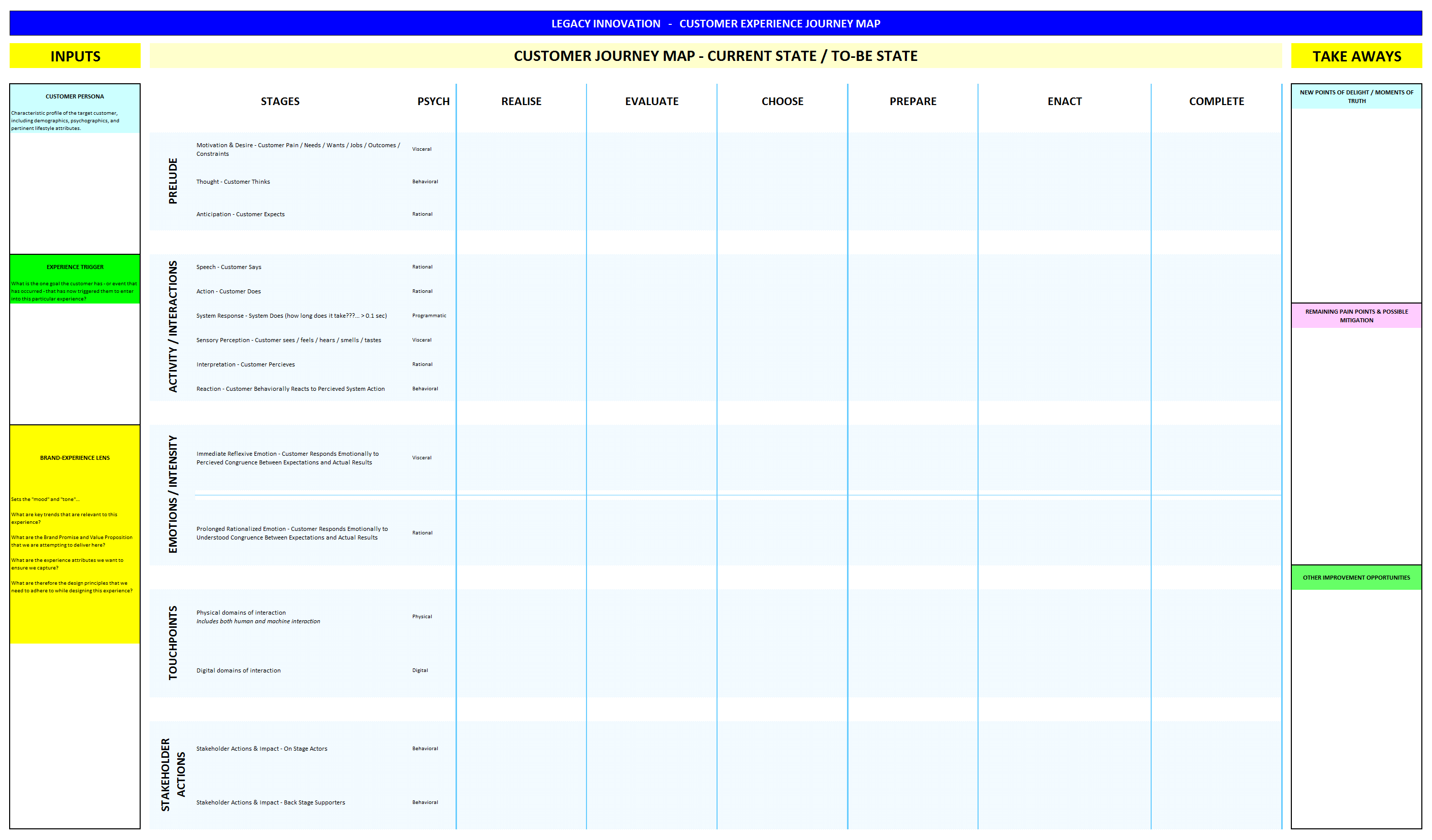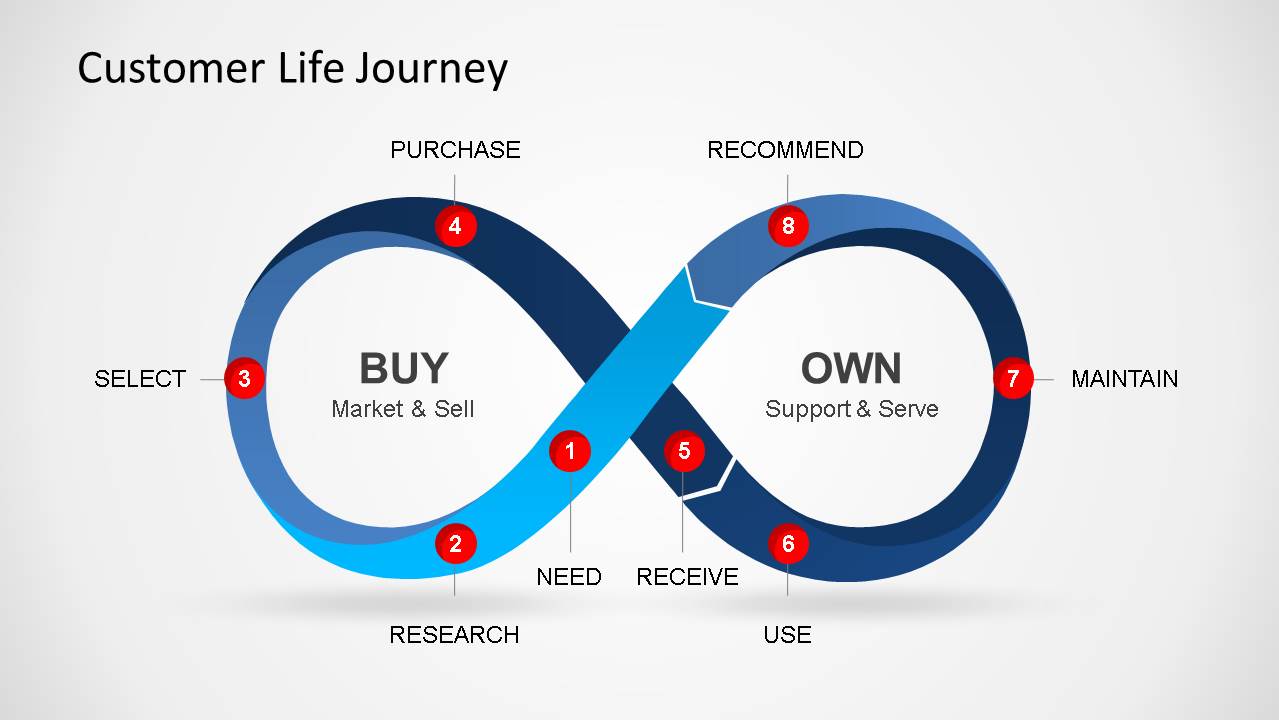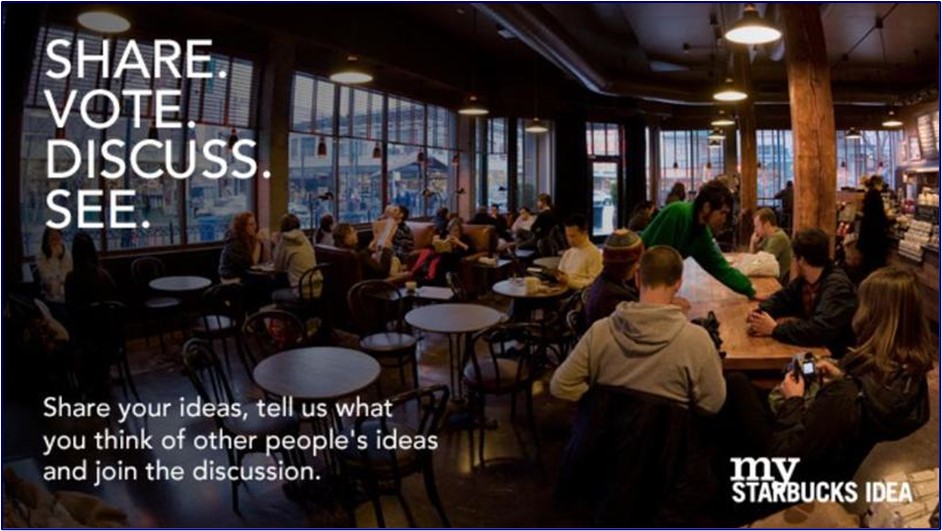Our process for designing innovative experiences derives from the established practices of Customer Experience Design (CXD) and Customer Experience Management (CXM). Together, these span the entirety of a well-defined customer lifecycle, a portion of which deals with buying the offering, and a portion of which deals with owning and using the offering.
In the way of analogy, one can think of delivering a designed experience as not unlike staging a theatrical performance – specifically one intended to deliver delight. In this performance there will be on–stage actors and backstage supporters, and their combined efforts must all be choreographed (designed) and subsequently directed (managed) if they are to in fact succeed at creating the intended delight. In order for this to happen however, the design process itself must be capable of achieving a very specific experiential outcome. Our design process is so capable.
Tactically, our design process uses the practice known as Customer Experience Journey Mapping, the tool for which is the CX Journey Map, or simply CXJM. In the act of using this practice, we step through any number of individual touchpoints taking place between your organization and the customer, and at each touchpoint we undertake what is known as Cognitive Task Analysis. This analysis, which draws from the field of psychology known as Experience Psychology (a form of cognitive consumer psychology), seeks to study and understand the customer's thoughts, attitudes, emotional states, and actions at that touchpoint. These customer states arise out of the extent to which the customer's needs and expectations are or are not being met at that touchpoint. Our goal in this situation is to understand those needs and expectations – and to the extent possible help shape them – so that we can meet or exceed them and thereby create for the customer an overall positive experience. It is imperative, therefore, when designing new experiences, that we fully understand and appreciate these psychological states so that we can work with them to deliver the intended brand experience.
The Customer Experience Journey Map (CXJM) is shown here...

The Legacy Innovation Experience Design Process involves a sequence of ten (10) steps that we undertake to deliver innovative experience designs.
They are as follows:
The first step is to think about who – and what – must be involved in delivering this new experience. These are the experience's ‘stakeholders’.
It is very important that as we design the experience, each of these stakeholders has representation in the design process. This is because they will have to sign up for delivering their part of the experience. Thus their input upfront will prove critical if we are to achieve optimal experience delivery and from this, a successful business outcome.
This is also the place where supporting systems and processes that enable the delivery of this experience are to be identified and verified.
It is sometimes helpful at this point to work through a Stakeholder Analysis, as this captures not only who each stakeholder is, but also the "what's in it for me" for each stakeholder. Understanding this is important, as it allows the organization to properly address each stakeholder's key motivations for delivering an exceptional experience and then act accordingly.
As we work through the ensuing design process, it is possible that additional stakeholders will be identified further along in the process. Whenever this occurs, those stakeholders will be asked to join into the design process as well.
The second step is to explicitly state the goals and objectives, or desired outcomes, of the experience design. It is important that everyone involved in the design process understands these up front, as that will ensure the Design Team stays focused on pursuing those specific outcomes throughout the process.
The third step is to establish a set of relevant KPIs associated with delivering the new experience that will result in a positive ROI for the organization. This set of metrics is referred to as the experience's ‘impact’ (meaning impact on the organization).
These should involve specific and objective metrics that can be tracked over time in order to gauge the effectiveness of the experience delivery. They should also be things that are clearly tied to the outcomes outlined in the prior step and that are meaningful to the organization and its top line.
The fourth step is to document personas representing the specific market segments being targeted. These communicate who the customers are that will be encountering this new experience.
Each persona will reflect important psychographic and demographic details about that particular segment, as well as what that segment's needs, motivations, and desired outcomes might be at each of the touchpoints in the experience.
The delivery of this experience serves as the bridge between your customers and your brand... the one thing that brings them together into an ‘encounter’.
The Brand Experience Lens is that collection of ideas and statements that focuses the design and delivery of this experience in such a way as to yield a very particular brand experience. It offers the guidance needed to create the intended ‘mood’ and tone for the experience, and as such, enables the experience to serve as the bridge to your customers in the way intended.
The Brand Experience Lens consists of the following six items:
Key Trends or Situations — these simply set the context for why your brand will be able to connect with your customers.
Brand Promise — this is the fundamental way in which your brand will improve the lives of your customers... how it makes their lifestyle or workstyle better.
Brand Message — these are the words and imagery you choose to use for communicating your brand promise.
Value Proposition — these are the specific tangible outcomes your experience brings that are of concrete value to your customers.
Design Principles — these are key principles your design needs to adhere to in order to ensure that each of its touchpoints is coherent with your broader brand message / brand promise.
Experience Attributes — these are specific attributes of the experience that serve to bring the brand promise and value proposition to life... they set the experience apart and make it uniquely about your brand.
Because talking, thinking, and working in stories is a powerful way of engaging the human mind, we employ the concept of Future Stories for starting the conversation around what a new customer experience might look like. This is a highly effective method for crafting compelling stories that capture a vision of how the experience is to be delivered and ‘consumed’. Because these stories evoke the imagination, they enable participants to form very lucid ideas of what the experience is to feel like.
Future Stories are captured and refined through storyboarding, a visual depiction of the story. Using storyboarding and dialogue, we lead teams in developing a series of compelling Future Stories that each clearly articulate a particularly unique experience. By laying out each Future Story visually in a storyboard, participants are able to form a clear mental image of what that particular experience will look and feel like. This can help teams to narrow down alternative stories and focus in on a few ideal stories and experiences.
Wherever a product or service is involved, the Future Story also serves to capture how that offering's design might be approached to achieve that experience through specific design attributes (including those of the business model, product, service, package, marketing, and so on).
At this conceptual level, we typically aim to select the one or two most ideal Future Stories to further develop as detailed experience designs.
At the heart of Experience Design is the process of Journey Mapping. In this process, we engage the team to map out the various points of encounter of the experience – known as its touchpoints. These are mapped along a touchline (aka a behavior line) that flows throughout the different touchpoints and ties them together across the entire experience. At this early point, the aim is only to capture the touchpoints, but not yet any of the details of the touchpoints, as those will be filled in the next step.
This activity is undertaken for each of the eight (8) distinct stages in the Customer Life Journey (aka the Customer Lifecycle), the first four of which deal with the BUY cycle, and the last four of which deal with the OWN cycle. These eight stages are:

Wherever any research exists around an existing or surrogate experience (such as in-depth interviews with existing customers) that reveals insights about how that experience is or is not delivering its intended outcome, those insights should be reviewed and discussed in relation to the new experience's initial design. Such insights can relate to how customers encounter the experience, or they may relate to how stakeholders deliver the experience.
One key thing that such research can reveal is which touchpoints are of highest importance to customers, as well as which touchpoints represent the highest amount of ‘pain’, ‘angst’, ‘frustration’, or ‘roadblock’ for customers (or for stakeholders). Where combinations of high importance and high pain can be found, this helps the organization to know how to prioritize its focus so as to best utilize its limited resources in the refinement of specific touchpoints.
At this point, having completed the prior steps, the team is ready to begin detailing the Journey Map – either the entire Journey Map, or in some cases, key portions of it (those touchpoints identified as having the biggest impact).
For each touchpoint of interest, we will capture the following attributes:
It is at this step that the detailed picture begins to emerge around what is happening to/for/with the customer within the experience. Wherever there are points of high impact in the experience that are critical to fulfilling the brand promise, we refer to these as Moments of Truth. These are the critical touchpoints that ultimately shape the message that actually gets sent about the brand, and which in turn serve to shape customers' understanding of what the brand is really about. These are those crucial points between what you say your brand is about and what it is actually about. They therefore must be coherent. Otherwise your brand will fail to connect and be successful.
Often the very first point of contact between a customer and your brand is called the Zero Moment of Truth – where the customer first becomes aware – usually through research and referrals – of the brand / organization as an option for them. Similarly, the point of purchase of a chosen option is sometimes referred to as the First Moment of Truth, while the point of initial use of the product or receipt of the service is referred to as the Second Moment of Truth. These specific touchpoints do indeed tend to be of high importance in the overall experience, and thus have a large impact on the customer's overall impressions of the experience and the brand (and thus your organization).
Depending on how well a particular touchpoint, or series of touchpoints, meets, exceeds, or fails to meet the customer's expectations and needs (some of which will have been shaped by the brand promise we have made), Moments of Truth will be experienced as either a WOW (a really great experience) or a BOOM (a really bad experience). BOOMs represent challenges that need to be addressed in order to avoid sending a negative brand message, while WOWs represent opportunities that can be further leveraged to more deeply impress a positive brand message. WOWs result in positive reviews; BOOMs result in negative reviews. WOWs create high customer loyalty (and thus a high Net Promoter Score); BOOMs erode customer loyalty. As can be seen then, it is crucially important that we understand the customer's needs and expectations at each touchpoint (including influencing those appropriately), and then work very hard to meet or (preferably) exceed them so that we create WOWs and a positive impression of our brand.
The Journey Mapping process will tend to be cyclical and iterative. For example, it may be discovered that within a certain touchpoint the customer gets to a place where they need something but do not have easy access to it. Here the team will need to circle back and rectify this within a prior touchpoint or a prior phase of that touchpoint before proceeding. This is done until the team arrives at a final experience design that captures what they are striving for. As needed, these cyclical revisions can also be accompanied by additional storyboarding to bring the visual element back into the process.
As desired, multiple versions of the Journey Map can be created to model any number of competing experiences. This allows the team to vet several possible experiences against previously established business metrics and elements of the Brand Experience Lens.
It is also helpful at times to use Swimlane Analysis to map out the different on-stage actor and backstage supporter actions. This lets the team see how all of the various stakeholder actions must synchronize with one another functionally and chronologically.
Wherever a new product, service, or business model is involved, it is crucial that the attributes of the overall customer experience (for each touchpoint) get translated into corresponding attributes for that product, service, or business model. This ensures that the attributes of the product, service, or business model are such that they will, in fact, deliver their part of the overall experience.
The process that Legacy Innovation Group uses for doing this rests on our unique design philosophy – known as the Designed Experience Approach. It involves a four-step methodology that defines: A) the brand experience (foundation); B) the overall customer experience, or some key portion thereof (manifestation); C) the product, service, or business model experience (translation); and D) the final product, service, or business model design (realization). Altogether, the work products of these four steps constitute what we refer to as the Designed Experienced Model.
A key tenet of the Designed Experience Approach – arising as it does out of Experience Thinking – is that the product, service, or business model design cannot be considered complete until it has fully captured all of the relevant experience attributes and translated those into corresponding product, service, or business model attributes. This means the design work cannot proceed until we have first worked through the first three steps of this process. This ensures the final design is capable of delivering on its intended experience.
The tool we use for translating experience attributes into corresponding product, service, or business model attributes is known as the Product Experience Framework, or PX Framework. For each touchpoint, the PX Framework captures the following details:
Of particular importance here are the target attribute values for each event. Later on, these will serve as pertinent metrics against which competing product designs, service designs, and business model designs can be evaluated.
When all of the above steps have been completed, our Experience Designers – working together with your team – will have converged upon an optimal Experience Design that is capable of delivering the intended experience. The end result is documented in an Experience Design Brief, which prescribes the Experience Design in detail, including an infographic depicting the newly–designed customer journey.
If the Emergent NPD Process is being used, this detail will facilitate moving into Phase 5 (Design Strategy), and will put the stake in the ground necessary for guiding the remainder of the development effort in subsequent phases.
The primary tool we use for designing innovative new experiences is our Customer Experience Journey Map, or CXJM. For more details, see the Legacy Innovation CXJM within the Legacy Innovation Toolkit.
A secondary tool we use – in this case for translating experience attributes into design attributes for new product, service, and business model designs – is our Product Experience Framework, or PX Framework. For more details, see the Legacy Innovation PX Framework within the Legacy Innovation Toolkit.
Another secondary tool we use – in this case for studying and designing new experiences from the organization's workers' point of view (employee experience design) – is the Legacy Innovation Service Blueprint. For more details, see the Legacy Innovation Service Blueprint within the Legacy Innovation Toolkit.

CEOs come and CEOs go. Some are excellent. They generally ‘get it’. Others not so much. They really ‘don't get it’. What makes the difference between these?
READ MORE
There's an insidious debate that's bounced around for probably the better part of twenty years now. It's the debate of whether or not ‘innovation is everyone's job’...
READ MORE
Innovation Spaces – which can refer to any space intentionally designed to foster and facilitate good innovation work – come in all sorts, shapes, and sizes...
READ MOREWe partner with committed business leaders to make their organizations the driving forces in their markets.
CONTACT USSign up for our newsletter.
NEWSLETTER SIGN-UP